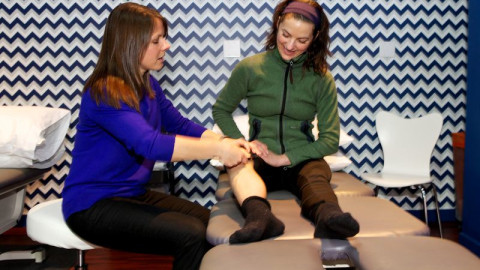Bike to Work Week is around the corner and whether you’re getting back on the saddle after a long hiatus or have been cycling for years, having the right bike fit is the best way to prevent injury and improve performance. If you have ever experienced neck pain, hand numbness or lower back aches, chances are these could have been prevented by having the right bike posture and fit. With a proper bike fit, you can walk into work this Bike To Work Day feeling refreshed and ready to conquer the day.
Bike Fit Benefits
Bicycles come in multiple sizes but they aren’t custom-fitted to your body. Lower back pain and knee pain are the most prevalent injuries with cycling. A comprehensive bike fitting will take into account your individual biomechanics to prevent injury and aid you in reaching your peak performance.
- Prevent Injury by establishing neutral positions that reduce stress on your body. This is especially important if you have recurring injuries.
- Improve performance by finding comfortable positioning that will allow you to exercise more effectively and build strength.
- Master your technique by making sure all of your body is working in sync for a more seamless ride.
- Experience a more enjoyable ride because you will have peace of mind, you will be comfortable and will start feeling improvements, which will help motivate you.
Tips for a Good Bike Fit
Minimal changes with a bike fit can provide exponential beneficial changes biomechanically. However, before making multiple changes, consult a professional to access your overall movement. There are multiple parts of a bike fit and depending on your pre-existing areas of pain, you can ask your physical therapist to hone in on those areas. Below are common pointers we give to cyclists of all levels who are looking to improve their cycling posture.
- Keep your elbows slightly bent instead of fully extended. Having bent elbows will help absorb shock through your upper extremities and reduce stress on your cervical spine.
- Maintain a neutral spine. This helps keep you from hyperextending your neck by trying to maintain an upward glaze. Without proper trunk alignment or thoracic spine extension riders often experience hyperextension injuries in the head and neck region from trying to maintain an upward gaze without proper upper back mobility.
- Make sure your handle bars are not too low, too high, too far or too close. Poor handlebar positioning may cause stress on your spine as you try to sustain a proper position. It may also result in hand pain or numbness due to your grip.
- To keep a neutral pelvic alignment, don’t tilt your saddle downward. A downward tilted saddle may put unnecessary stress on your wrists. It may also impact your erector spinae, multifidus, obliques and quadratus lumborum if your muscles have poor endurance.
- Find the right saddle and don’t raise it too high or too far back. Oftentimes riders change the angle of the saddle for comfort rather than actually assessing if you have the right saddle fit for your body type. Before changing the position of your saddle we recommend finding the right saddle fit first. When you ride your knees constantly maintain a semi-flexed or mid-range contraction, which can put stress on your hamstrings. When a saddle is placed too high often times this places the pelvis in a posterior tilt creating a biomechanical shortening of the hamstrings. This can lead to muscle strains or even numbness and tingling in your legs during long rides.
- Wear padded gloves and proper shoes. During long rides you may grip more tightly or apply more pressure with your feet while pedaling. Wearing the proper gear is just as important as your position on your bike to reduce stress and let you enjoy your ride.
Physical therapists aren’t just great to help you recover from your injury or surgery, but they are an essential part of your lifetime wellness and preventative care. Your physical therapists knows your body, your limitations and your goals. They will be able to find the right bike fit that works for you and keep in consideration any previous or recurring injuries you may have to get the most out of each ride. A physical therapist will work with you one-on-one to make adjustments to your bike fit over time as you improve and build strength.









